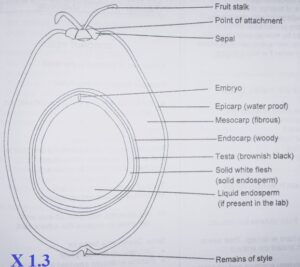Biology Practical questions and answers (Section 2).

Specimen A – Orange fruit
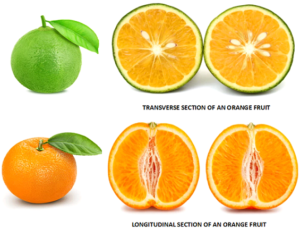
Specimen B – Tomatoes fruit.
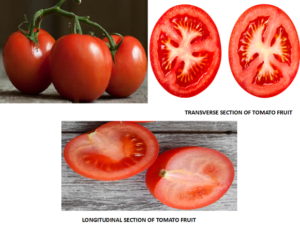
Specimen C – Coconut fruit

Specimen D – Pawpaw fruit.
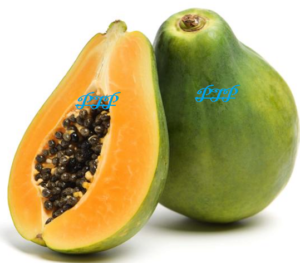
Specimen E – Pod of cowpea.
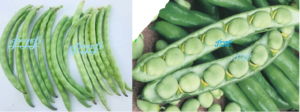
Specimen F – Fruit of Tridax.
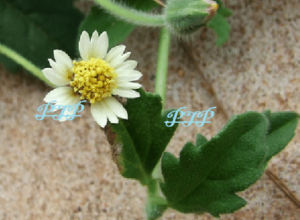
Specimen G – Sugar cane stem.
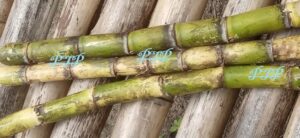
Classify specimens A, B, C, and E
Specimen A
- Is a Berry
- True Fruit
- Simple fruit
Specimen B
- Is also a Berry
- True Fruit
- Simple fruit as well
- Fleshy fruit
Specimen C.
- Is a drupe
- True Fruit
- Fleshy fruit
Specimen E
- It is a simple fruit
- Dry fruit
- Dry dehiscent fruit
- And a legume
State the placentation in specimens A, B, C, D, and E.
Specimen A
- Axile placentation.
Specimen B
- Axile placentation
Specimen C
- Basal placentation
Specimen D
- Parietal placentation
Specimen E
- Marginal placentation
Give the mode of dispersal of specimens B, and C, and state at least three reasons in each case.
Specimen B
- Specimen B is dispersed by animals such as birds and humans.
Reasons:
- It has a brightly coloured epicarp which attracts animals.
- It also has fleshy and succulent mesocarp which attracts animals.
- The seeds are also possessing hard testa which resists digestion in the animals.
Specimen C
- Mode of dispersal is by water.
Reason:
- It is light in weight
- The specimen possesses a fibrous mesocarp with numerous air spaces to provide buoyancy.
- The endocarp is hard and stony to protect the embryo of the seed.
- Presence of waterproof epicarp.
Explain briefly how each of the specimens A, E, and F is dispersed.
How specimen A is dispersed.
- Specimen a are dispersed by animals (birds).
- The juicy/fleshy mesocarp and coloured epicarp attract the birds.
- The fruits may be carried to a different location by the animal.
- They feed on the fruit and the small seeds might be swallowed.
- Some seeds may fall on the ground as the animals feed on the fruit and germinate there.
- The seed if swallowed has hard testa which cannot be digested by enzymes.
- The undigested seeds are then deposited with faeces and also germinate if the ground is fertile.
- Some of the sticky seeds are likely to adhere to the body or beak of birds as they feed and these seed fall elsewhere as they fly and also germinate there.
Dispersal of specimen E.
- The mode of dispersal is the explosive mechanism/mechanical dispersal.
- Uneven drying of the pericarp of the fruit.
- Generate tension in the fruit causing the wall of the fruit to split open.
- As the fruit split open, the seeds are thrown away from the parent plant to new locations
- Thereby causing dispersal.
How specimen F is dispersed.
- The specimen F is dispersed by wind.
- The seed is small in size and also light in weight
- This makes it to be easily carried by air/wind.
- The seeds are also hairy/feathery calyx/pappus allowing it to form a parachute and float in the air.
- To be carried to different locations.
Section through the specimens A, B, C, D, and E transversely and longitudinally. And state four observable features of each of the specimens sectioned.
Features of specimen A.
- The endocarp is fleshy
- Succulent mesocarp
- It has seeds
- Possess placenta
- Several chambers
- Point of attachment
- The epicarp is brightly coloured.
Features of specimen B.
- The epicarp has a bright colour and smooth
- The mesocarp is succulent.
- Endocarp is fleshy
- Seeds are present
- Placenta is also present
- Several chambers where seeds are located
- Point of attachment
Features of specimen C.
- Single but large seed.
- Fibrous and spongy mesocarp.
- Hard endocarp.
- The epicarp is also smooth and maybe green in colour
Features of specimen D.
- Green or orange epicarp.
- Succulent mesocarp
- Fleshy endocarp
- Juicy around the seed but with hard testa.
Features of specimen E.
- Presence of locules
- Presence of seeds
- Presence of funicles
- Remains of style
- Scar of fruit stalk
- Placenta and calyx are also present.
- Pericarp
- Sutures
Make a labelled drawing of 8cm – 10cm long of the longitudinal section specimen E.
A labelled drawing of the longitudinal section of specimen E
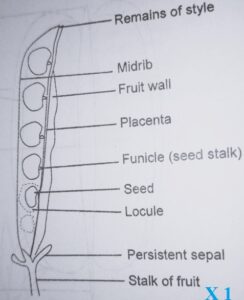
State observable differences between specimens A and B.
|
Specimen A |
Specimen B |
| Seeds a relatively large | Seeds are relatively small |
| Epicarp is rough | Epicarp is smooth |
| The epicarp is thick | The epicarp is thin |
| Have relatively hard mesocarp | Have relatively soft mesocarp. |
| Epicarp is yellowish | The epicarp is bright red |
State the class of specimen G and give two reasons for your answer.
- Class Monocotyledoneae
Reason:
- Possess narrow leave
- Leaves have parallel venation
- Also, the presence of leave sheath.
State the habitat of specimen G.
- Waterlogged soil
- Marshy areas
Make a labelled drawing of the transverse section and longitudinal section 8cm – 10cm long of specimen A.
A drawing of the longitudinal section of specimen A

A drawing of the transverse section of specimen A
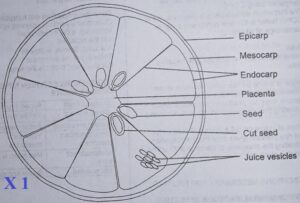
State the observable differences between specimens A and C.
|
Specimen A |
Specimen C |
| Have rough epicarp | Have smooth epicarp |
| Presence of juicy and succulent mesocarp | Presence of spongy and fibrous mesocarp. |
| Endocarpp is soft | Endocarp is hard. |
| Seeds are small and numerous | The seed is large and only one is present |
| It is multilocular | It is unilocular |
Make a labelled drawing of the transverse section and longitudinal section 8cm – 10cm long of specimen B.
A labelled drawing of the longitudinal section of specimen B
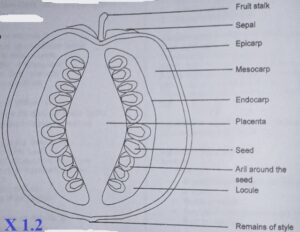
A labelled drawing of the transverse section of specimen B
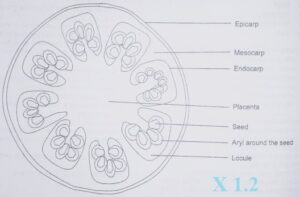
List the observable differences between specimens D and E.
|
Specimen D |
Specimen E |
| Has parietal placentation | Has marginal placentation |
| Several seeds present | Few seeds present |
| The seed is relatively small | The seeds are relatively large |
| Has sweet scent | Not sweet-scented |
| Brightly coloured pericarp | The pericarp is relatively dull |
| Fleshy and juicy pericarp at maturity | Dry pericarp at maturity. |
Make a labelled drawing of 8cm – 10cm long of the longitudinal section specimen C.
A labelled drawing of the longitudinal section of specimen C
